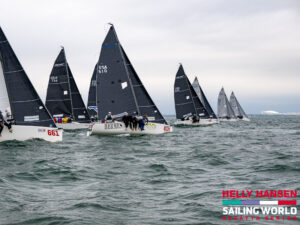
MARBLEHEAD, Mass.–Mention the word Thunderbird to most sailors and its likely to conjure up images of a classic sports car, or maybe hazy, regrettable memories of some cheap wine and the resulting hangover. But for racers competing in the 2002 Sailing World NOOD at Marblehead Race Week therell be another image to add to that incongruous duo: that of a 26-foot hard-chined sailboat with an enormous mainsail and an interesting cast of characters piloting them around the course.
First built in 1958 in Seattle, the Thunderbird is certainly the oldest rookie among the many classes that will compete in the nine 2002 NOOD Regattas, and one of the few NOOD classes in history that is largely home-built. It does, however, seem like a good fit for Marblehead, a place where traditional classes like the Town Class, the IOD, the Corinthian, and the Rhodes 19 rule the waters. Sean Kane, of Thunderbird Fleet 5 in Boston, pushed to get the class to this regatta hoping to get some exposure. Eight local boats showed up and made their NOOD debut today in a dying easterly breeze and some solid Atlantic swell.
I crewed on one in 1995, says Kane, a 29-year-old accountant, and it was four boats actively racing. Every year since then weve gotten an additional one. I thought this NOOD regatta would help let people know the boat is out there.
Kane says the local fleet, which is based largely at the Savin Hill YC, now numbers around 14 boats, and is back on the rise after a slight downward trend in the 90s. The boat sails better than any boat Ive been on, he says. One person can go out and daysail it. It only takes three to race and the fleet is so competitive. Today we had three different winners. It offers great one design racing for minimal dollars–these boats are free if you want to take on a big project.
The Thunderbird was drawn by Seattle-based naval architect Ben Seaborn in response to a request from the Douglas Fir Plywood Association for a sailboat that would be, both a racing and cruising boat; provide sleeping accommodations for four crew; be capable of being built by reasonably skilled amateurs; provide auxiliary power by an outboard motor that could be easily removed and stowed; and out-perform other sailboats in its class. Since then over 1,200 of the 26-footers have been built, with fleets in the U.S., Canada, and Australia. While there are fiberglass hulls available, most of the boats are built of wood. Kane says that a saturation of the used Thunderbird market means the boats are available for a quite reasonable investment and since theyre made of wood with a glass overlay, theyre fairly simple to repair–you just cut out the old piece of wood and slap a new piece in there, says Kane.
Though he now owns one of the few fiberglass T-birds in the Boston fleet, 61-year-old Pete Gilson is intimately familiar with the hands-on nature of the boat. My wife and I built the boat in 1968, launched it on Friday, got married on a Saturday, and spent a month-long honeymoon on it, says the retired aerospace engineer. After 18 years, we got tired of chasing dry rot and maintenance, so we transferred the keel, the mast, and all the fittings to a fiberglass hull built in Victoria, British Columbia.
Gilson won one of the three races today, but before anyone assumes that his plastic boat is inherently faster than the wooden ones, he adds that the only advantage he gets is he has less maintenance to deal with. Wooden boats won the other two races and currently one of the woodies, Ken MacLeods Flying Gull, leads the regatta, one point ahead of Kanes Chikanery. Gilsons Amra stands in third.
Kane said that no one sailed exceptionally well today, but that limiting mistakes, and mastering the lumpy conditions–the Boston T-bird fleet usually sails on more protected waters–were key. Kane also credited his performance today to the work of his crew. While leading the second race, the crew of Chikanery lost the spinnaker halyard up the rig. Before Kane could tell his crew to use the jib halyard to rehoist the chute, crewman Richard Bell was scampering up the rig to retrieve the lost halyard. They were able to hold on for the win.
Kane says that there are at least a dozen T-birds in various states of repair in the area waiting for the right craftsman to bring them back to life. For more information on the class, visit the class associations website (www.thunderbirdsailing.org). For information on Fleet 5, email Sean Kane at tbrd154@aol.com









